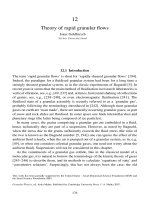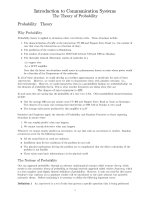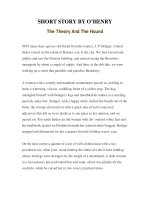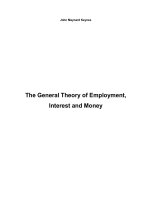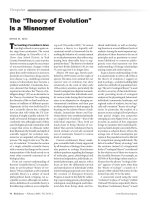Theory of The elemental Force of the Universe
Bạn đang xem bản rút gọn của tài liệu. Xem và tải ngay bản đầy đủ của tài liệu tại đây (708.5 KB, 149 trang )
Halit Eroglu
Theory of
The elemental Force of the
Un
i
verse
everything
10=⋅ch
This e-Book contains bookmarks (table of contest).
If you want to see a bookmarked page, click on the book-
mark's icon in the bookmark panel, and Adobe Reader will
go to that page.
You can display PDF bookmarks by following steps:
1. Click on "View" in Adobe Reader
2. Click on "Navigation Panels."
3. Click on "Bookmarks." The Bookmarks pane will open,
showing all bookmarks for the document.
Imprint
The Theory of everything
- The elemental force of the universe
www.hc10.eu
Coverbild © Sonja Janson - Fotolia.com
Copyright: © 2012 Halit Eroglu
This e-book is an English translation of the below work,
which was published in Germany. ISBN 978-3-8442-3885-3
"Die Weltformel - Die Urkraft des Universums"
Table of Contents
Foreword 1
1. Chapter 5
1.1. The Ether 7
1.2. The structure of the quantized space 11
1.3. The Final Formula 13
1.4. The Secrets of the universe 16
2. Chapter 19
2.1. The quantized magnetism 20
2.2. The quantized charge 23
2.3. The quantized mass 25
2.4. The quantized energy 29
2.5. The modified Planck-Units 30
2.6. The units invariance of the final formula 31
3. Chapter 39
3.1. Derivation of the electron mass 41
3.2. Derivation of the proton mass 43
3.3. The classical electron radius 44
3.4. Derivation of the proton radius 47
3.5. Derivation of the fine structure constant 56
3.6. Derivation of the acceleration due to gravity 60
3.7. Derivation of the gravitational constant 62
4. Chapter 69
4.1. Derivation of the speed of light 70
4.2. The origin of time 75
4.3. The origin of spatial dimensions 78
4.4. The origin of 83
4.5. The origin of the relativistic effect 87
5. Chapter 93
5.1. The Planck time 94
5.2. The universal validity of the final formula 95
5.3. The time factor in the natural constants 98
6. Chapter 103
6.1. The structure of the universe 104
6.2. The genesis of space 106
6.3. The expansion of the universe 112
6.4. The basic fundamental forces 117
7. Chapter 121
7.1. The limits of mathematics 122
7.2. The Metalogic 124
Epilogue 128
Appendix 130
"
The most incomprehensible thing about the
universe is basically that we understand it."
Albert Einstein
1
Foreword
The fascinating thing about the universe is its space with the
immense micro- and macrocosm size. Not only in the macro-
cosm between planets, solar systems and galaxies, but also in
the microcosm in the atoms and its components is the
“empty space” is the decisive element. Therefore, one must
first of all understand the “empty” space of which it mainly
consists in order to be able to understand the universe as a
whole.
It is known that the “empty” space in fact is not empty but
contains virtual particles, ominous dark matter and dark en-
ergy.
• However, what are the empty space and thus the entire
universe?
• What is energy, mass, charge? What do they consist of?
• Why is the speed of light constant?
• Is it possible to derive the constants of nature?
• Does a Theory of everything exist?
Inter aila, we will have a look on these questions and solve
some other mysteries of the universe. Thereby, new ques-
tions and new mysteries will arise, but we will see that the
universe, made up of space, time and energy is made up in
an unprecedented form.
The new world model is a theory which currently is in devel-
opment, some of the results and the "final formula" hereby is
published. In this edition, I am handling the key aspects of
the new model of the world. Based on equations derived
2
from fundamental physical constants of nature that play a
central role in physics, I will demonstrate that it is possible
to explain the entire universe with a brief "final formula".
With the aid of the final formula, we also will experience
how time works and how the three-dimensional space is cre-
ated.
Many smart people have tried for a long time to derive all
physical properties of the universe from a single formula.
However so far, all attempts have failed. It seems that the
reason for this failure was the imperfection of the existing
theories. Viewing the universe from a different perspective
and leaving the assigned paths of the previous theories, we at
least reach a world model with a final formula. With this
book it is demonstrated how to explain the recent recogni-
tions in physics also from another perspective. Accordingly,
modern physics is completed and enhanced.
I have not searched for the final formula, I discovered it by
chance, just like Archimedes who discovered buoyancy force
in the bathtub or Newton, who discovered the gravitational
force under an apple tree. Afterwards, I made some calcula-
tions with the final formula and have seen with a great aston-
ishment, that the entire universe can be explained with this
formula.
Also some problems with previous theories will be high-
lighted in this book:
• Newton believed that it was gravity which holds together
the universe. Even today many people believe in this but
3
no one is able to explain what actually causes gravity.
Thanks to the Final formula we are able to solve the
mystery of gravity and based on the derived gravitational
constant we will be able to learn how it works.
• Einstein could not exactly explain space and time al-
though his famous theories were based on it. He summa-
rized these as “Space-time” and assumed that the space
bended itself. With the final formula we now can reveal
the great secrets of space and time.
• Planck discovered the quantum of action and accord-
ingly laid the foundation for quantum physics. However,
his quantized quantities do include the gravitational con-
stant and are therefore useless, as we shall see in the ap-
propriate section.
But, dealing with the universe, the more clearly one recog-
nizes the outstanding achievements of the researchers at that
times of period. They do not lose at any way authority, on
the contrary, only thanks to their intellectual achievements;
we are now able to continue their scientific heritage. How-
ever, every theory becomes outdated over time through new
knowledge, and accordingly, science develops more and
more.
The individual chapters and sections in this book are based
on each. We will first start with the smallest dimension in the
microcosm and, in the penultimate chapter will try to de-
scribe some structures in the macrocosm. Since everything in
the universe depends on one another, it is inevitable that one
4
can understand much better the new world model and the
final formula, after reading the whole book. Because, much
more things will be more understandable in the overall con-
text.
Important note:
No original Planck units and their numerical values were
used in this book. However, in honor of Max Planck, I
have named after him the new quantized sizes. The
Planck mass, the Planck length, etc. should therefore not
to be confused with the original Planck units.
5
1. Chapter
In this chapter we will discuss the basis of the new world
model. Based on the structure of the quantized space and the
final formula, in later Chapters we will gradually explore
some features of the new model of the world.
For a better understanding, I will therefore refer to the fol-
lowing sections. The topics build on each other, and only
after discussing some principles, we will be able to deal with
more details in the later sections.
"It's not only about to see what everyone sees, but to think
with what everyone sees, what no one has yet thought of."
Arthur Schopenhauer
7
1.1. The Ether
The idea of an omnipresent ether as carrier of light, and thus
of any electromagnetic wave comes from Aristotle and was
later taken up by Newton. Since Newton, the space has been
viewed as a "container" in which all physical processes take
place. Even if it was not provable, Newton was convinced
that there is a substance that permeates the entire universe
and connects it with each other. He called this invisible sub-
stance "ether" and described it as a living, spiritual element.
Also, James Clerk Maxwell, the founder of the electromag-
netic theory believed in ether, calling it "a material sub-
stance that is more subtle than the visible body, and which
exists in those areas of space, which appear to be empty."
The notion of space, however, has changed dramatically in
the continued development of physics and at least was chal-
lenged by Einstein. Since then, formal properties of mathe-
matical spaces are used for its physical description.
As a seemingly disused physical concept, the ether hardly is
treated by a scientific theory today. Although it is still dis-
cussed today if it is possible to quantize the space, however
even in this matter the space considered as a mathematical or
geometric object.
It was failed to prove ether around the turn of the century,
and also in several later experiments. Albert Einstein could
then solve the difficulty by banishing ether from his equa-
8
tions and replaced it by the speed of light as a universal con-
stant. Thus, the failure of attempts to prove the ether gave
Einstein the impetus to develop the theory of relativity.
In one of his speeches, Einstein summarized the former idea
of the ether, and he expressed his views in detail about this
issue:
" Recapitulating: we may say that according to the general
theory of relativity space is endowed with physical qualities;
in this sense, therefore, there exists ether.
According to the general theory of relativity space without
ether is unthinkable; for in such space there not only would
be no propagation of light, but also no possibility of exis-
tence for standards of measuring rods and clocks, nor there-
fore any space-time intervals in the physical sense. But this
ether may not be thought of as endowed with the quality
characteristic of ponderable media, as consisting of parts
which may be tracked through time. The idea of motion may
not be applied to it."
When talking about the subject of ether it is often asserted
that Einstein would have abolished it. But how one can see
in his speech, he did not abolish the ether, but he has rede-
fined it according to his theory. So, he has modernized the
ether concept during that period.
It is interesting to experience what considerations are hidden
behind the fact that at the beginning of the last century the
debate in relation to ether was brought to an end. Not just
because the fact that it is not provable, but also because there
was no theory with which one could equally explain the
9
physical phenomena in the micro and macrocosm explain
using the properties of the space. In his speech, Einstein also
called attention to the following fact:
"Of course it would be a great advance if we could succeed
in comprehending the gravitational field and the electro-
magnetic field together as one unified conformation. Then
for the first time the epoch of theoretical physics founded by
Faraday and Maxwell would reach a satisfactory conclu-
sion. The contrast between ether and matter would fade
away, and, through the general theory of relativity, the
whole of physics would become a complete system of
thought, like geometry, kinematics, and the theory of gravita-
tion."
The above quoted speech of Einstein is very interesting for
the subject of this book, and therefore it is included in the
appendix of the book. In this speech, we get to know the real
reasons why the former idea of “material" ether, was aban-
doned in a justified way.
10
Why can the ether not be measured?
Since last century, the ether hypothesis is considered dead.
In later experiments it also was not possible to prove the
ether. In the many discussions on ether at the beginning of
the last century and even later, no one seems to have consid-
ered that the one thing they were looking for was simply too
small to be detected in experiments.
Apparently ether is considered as an element, which is large
enough to be proven. However already at the beginning of
the last century Max Planck -after the discovery of the quan-
tum of action-, has derived the units which were named after
him and has defined a tiny quantized quantity of the space as
a Planck length ml
P
35
10616199,1
−
⋅= . Latest after this rec-
ognition, the researchers should have actually been aware
that it is not possible to measure physical effects at these
small scales.
For centuries, the ether was defined with different, some-
times even bizarre theories. However, the new world model
is not based on the old ideas of space and the ether, so I will
not use that term.
In the following chapters we will see that the "empty" space
has a structure, which previously was unknown. Even if the
properties of the "empty" space can not be detected directly,
there is enough evidence for the existence of a " substance
that permeates the entire universe and connects it with each
other " as Newton had described.
11
1.2. The structure of the quantized space
As with any scientific model, also with the new world model
we try to describe the reality with basic elements. In the pre-
sented world model, the universe consists of simple compo-
nents. However, this should not obscure the complexity of
reality. An analog clock also consists of simple components,
such as of gears, screws, etc. Only the interaction of these
basic components according to a specific system brings the
clock running. In the universe it is the interactions of the
individual components that make the "clockwork" universe
running.
In the new world model, the complete space in the universe
so the vacuum in its smallest dimension consists of unified,
densely interconnected spheres with a strictly periodic struc-
ture which I have referred to as "Space Balls" in this book.
Figure: Vacuum filled with space balls
The sphere as a geometric body generally has special proper-
ties and for the given volume has the smallest surface area of
all possible body. This property is very important in the
quantization of the space. Therefore, the new world model is
12
based on these quantized space balls and not on other geo-
metric shapes such as cubes or pyramids.
In three-dimensional space, each space ball is directly con-
nected to 10 adjacent spheres. For uniform structure with the
same diameter and the same gravitation between the space
balls, there is an interaction with the factor 10 between the
space ball in the center and its adjacent spheres.
Figure:
Interaction between the space balls
The space balls are magnetic monopoles, and they pull each
other. All physical phenomena are the consequences of this
primal magnetism in the space balls. As we are going to see,
the charge, mass, and thus the basic components of matter,
atoms, stars, etc. arise from interactions between these space
balls.
For the present, this principle can describe as follows:
Magnetism > Charge > Mass > Particles > Atoms > Stars
1
2
3
4
5
6
7
8
9
10
View from above
Two-dimensional view
in a plane
13
I.e. the magnetism causes charges, and these generate mass,
which then form particles that accumulate in atoms and thus
produce all macroscopic bodies and celestial objects in the
universe.
1.3. The Final Formula
Many physical phenomena can be explained with the funda-
mental natural constants of speed of light and the reduced
Planck's quantum of action. In the new world model the fol-
lowing context constitutes the base of each physical event in
the universe, and it can therefore be defined as a "final for-
mula".
The Final Formula:
26
1010
−
⋅=⋅c
h
(1-1)
Speed of light with c=299.792.458 m/s
Reduced Planck constant with
π
2
h
=h
.
The reduced Planck quantum of action has been modified by
transforming the final formula with:
3426
1079390548222864,110
10
−−
⋅=⋅=
c
h
Planck's quantum of action is determined experimentally,
and physical measurements are always associated with
measurement errors. Even the most accurate measurement
can not provide a precise value. The determination of
14
Planck's quantum of action depends on many factors, so with
the above reduced formula of the Planck constant was modi-
fied. The absolute deviation from the CODATA value is
minimal and amounts:
34
1043104920002505611,0
−
⋅ .
The final formula has the dimension of energy times length
and thereby constitutes a universal relationship between en-
ergy content and length scale. It describes the amount of en-
ergy contained in the space balls and here, the quantized
length amounts as modified Planck length ml
P
26
10
−
= . The
dimension of the final formula with the general units eV in
nuclear physics is:
⇒⋅=
⋅
P
l
e
e
c 10h
197, 39208802178700 MeVfm
Despite to the above modified , the modified value from the
next Chapter was used for the elementary charge e.
The final formula
26
1010
−
⋅=⋅c
h
means that the space
balls with the diameter of
P
l contain a certain amount of
energy 10 . The interaction between the space balls is
done with the time factor contained in the speed of light
and the smallest action .
The constant speed of light is used as the time factor in the
pulse transmission and therefore, also the quantized action
is constant. When asked which of the two existed at first
(Hen-egg problem), we can say with certainty that the time
factor which is measured from the speed of light is given,
15
and that
is directly dependent. In the Chapter "derivation of
the speed of light," we will continue to discuss the phenome-
non of the time factor.
The attraction in the space balls in the form of energy with
10 and the universal time factor with the speed of light,
are the only basic elements with which the universe is built.
The modified Planck quantum of action as the smallest effect
also plays a big role, but this quantity directly depends on the
speed of light and therefore can be derived from it.
With the "final formula" it is possible to make a clear and
unambiguous description of the phenomena observed in na-
ture. The simple formula also allows predictions about new
phenomena.
The final formula is harmless and any concerns that zealous
scientists could use it to play "God" with it and turn the
world upside down, are unfounded. The left side of the for-
mula contains natural constants that have long been known
for a long time and are used daily in nuclear physics. My
discovery relates to the right side of the formula, and it ex-
plains to what the fundamental constants of nature, the speed
of light and the Planck constant can be attributed to.
According to the new world model, space and time is quan-
tized in the universe. In addition to the elementary magni-
tudes such as the Planck mass, the Planck charge etc., also
some fundamental constants of nature, and even the speed of
light can be derived with the final formula. We also will gain
16
new insights on the nature of time and the three-
dimensionality of space.
1.4. The Secrets of the universe
In physics, there are some natural laws, but many scientific
theories. There are also rather interpretations, opinions and
hypotheses on which these theories are based on.
If we leave aside the theories and the various opinions and
interpretations as "man's work", then only the laws of nature
will remain. The empirically confirmed and universally valid
laws of nature do explain the relationships and interrelation-
ships of physical phenomena. However, there is a problem:
they contain partially natural constants that only can be de-
termined by measurement. While describing the processes of
nature, one will encounter physical constants, whose values
can be measured, but so far no one knows what they are to
be attributed to.
The secrets of the universe are thus hidden in the constants
of nature. Consequently, many well-known physicists had
the desire to derive the number of fundamental constants
from a single constant.
There are over a hundred fundamental constants, but only
about two dozen of them are elementary, and the rest can be
derived from them. After the discovery of the final formula I
have therefore derived the basic constants of nature, because
it is possible to explain the entire universe with them. The
17
derived constants of nature have been selected after careful
consideration, and as we shall see later, even these funda-
mental constants of nature are based on a single number,
namely the elementary constant.
Einstein also was dissatisfied with the constants of nature,
and he has described it as follows: " I cannot compellingly
think of any reasonable and consistent theory that explicitly
contains one number which could also have been chosen as
another number by the whim of the Creator, where the world
qualitatively would have been represented in a different way
in its laws. "
For Einstein, the most elementary constants of nature such as
the speed of light, gravitational constant and the Planck
quantum of action were not really fundamental, because their
value still depends on "conventional" units. Only if it could
be succeed to create one quantity from several constants that
is a pure numerical value without unit of measurement, then
a universal constant would exist according to Einstein's
view. However the numerical value of this universal, abso-
lute constant should be determined by the logical basis of the
physical theory.
The number
10 in the final formula is the universal ele-
mentary constant, and we will gradually learn their special
characteristics in the following chapters.
The below listed nature constants and some important physi-
cal quantities have been derived with the final formula. As
we are going to see, all fundamental constants in physics can
18
be attributed to a single number
10 as the elementary con-
stant.
=
c
speed of light
=
h
reduced Planck quantum
=
P
l Planck length
=
P
t Planck time
=
e
elementary charge
=
e
m electron mass
=
P
Q quantized charge
=
P
m quantized mass
=
G gravitationnel constant
=
ot
m
Pr
proton mass
=
α
fine structure constant
=
e
kr classical electron radius
=
g
acceleration of gravity
P
l
c
h
P
t
e
e
m
P
Q
P
m
G
ot
m
Pr
α
e
kr
g
10=E
19
2. Chapter
Starting with the Planck length ml
p
26
10
−
= , the enormous
dimensions in the microcosm provide ample space for parti-
cles, charges, photons. These elements, in fact are already
formed in the smallest plane in the Planck sphere. Therefore,
the microcosm is like an ocean of microscopic particles and
radiation.
In the macroscopic length scale in the laboratory we only can
study large concentrations of these elements. In experiments,
indeed, we observe the existence of tiny particles or radiation
seemingly to arise out of nowhere and disappear again.
Therefore we call them virtual particles or vacuum fluctua-
tions. However, also these particles are already large collec-
tions of quantum objects, which we will discuss in the fol-
lowing chapters.
Note:
In the following chapters, equations are derived to make
certain connections clear. Here, the Planck length wasn't
used in order to ensure clarity. The multiplication by the
number one in the Planck length has no effect on the
numerical values. During the comparison of equations
derived with CODATA values, however, the Planck
length is included in the extension with the orders of ten.

